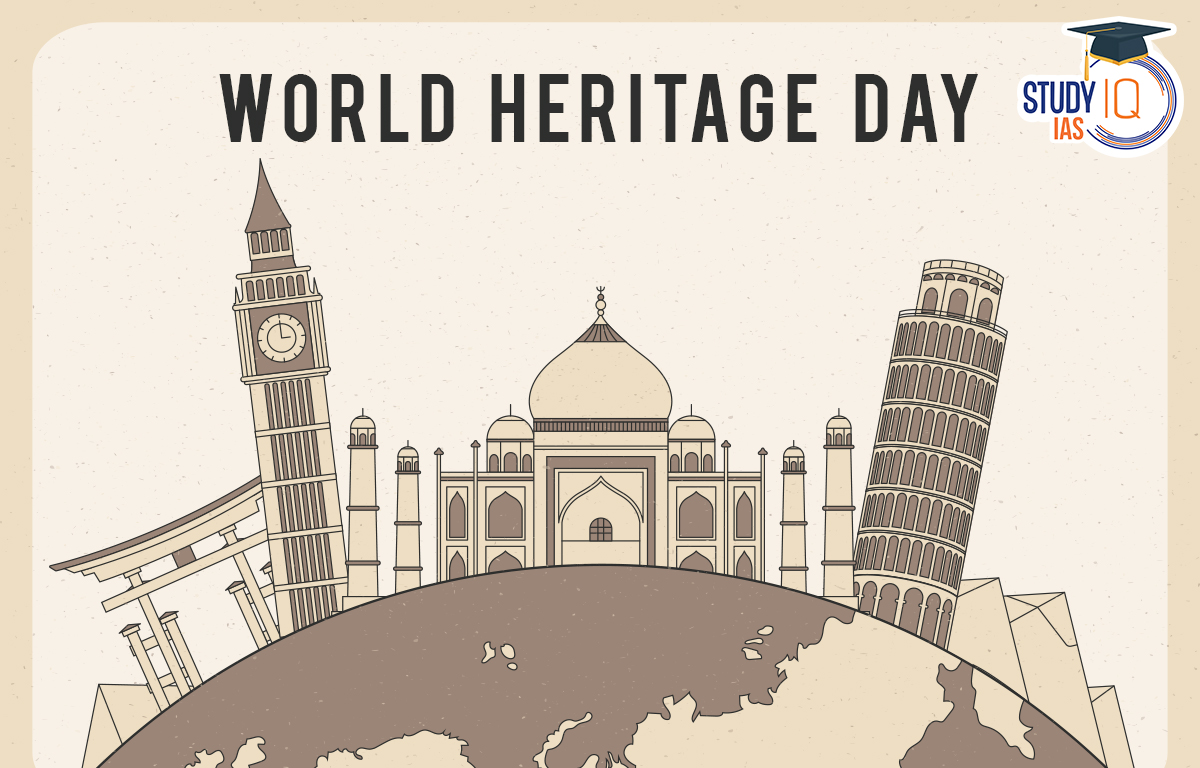Table of Contents
World Heritage Day, celebrated every year on April 18, is a very significant day of contemplation and action for the international community, underscoring the significance of cultural and natural heritage preservation. As we make our way into 2025, this day reminds us to admire the beauty of the historic buildings, sacred places, and natural splendours, and remember the increasing threats they are subjected to. Under a theme of conflicts and disasters, this year’s commemoration highlights the vulnerabilities of these priceless assets and the need for concerted action to safeguard them. Whether an ancient temple, a grand palace, or a biodiversity-rich national park, every heritage site has a story that weaves past into present and future.
In this article, we’ll explore the theme, objectives, and significance of World Heritage Day 2025 and its growing importance in today’s ever-changing world.
World Heritage Day 2025
Annually, on April 18th, we commemorate World Heritage Day, also termed the International Day for Monuments and Sites. This occasion aims to spotlight the remarkable cultural and natural wonders acknowledged by UNESCO’s World Heritage List. It serves as a reminder to cherish and protect our cultural heritage. Like precious gems, ancient monuments and buildings require careful preservation to withstand the passage of time.
What is World Heritage Day?
World Heritage Day or the International Day for Monuments and Sites (IDMS) is observed all over the world to create awareness about the significance of the conservation and recognition of the cultural and natural heritage of the Earth. It was created by the International Council on Monuments and Sites (ICOMOS) in 1982 and endorsed by UNESCO in 1983. The day commemorates the importance of conserving these valuable monuments, natural sites, and cultural landscapes in a way that supports sustainability to preserve them for generations to come. The observance is a call to all — from governments and communities to tourists — to join the global effort to save our common heritage.
World Heritage Day History
Every year on April 18th, World Heritage Day, also known as International Day for Monuments and Sites, is observed to raise awareness of cultural heritage and to advocate the preservation and protection of significant historical sites around the globe.
ICOMOS (International Council on Monuments and Sites) introduced the proposal for World Heritage Day in 1982, and UNESCO (United Nations Educational, Scientific and Cultural Organization) later endorsed it during the 22nd General Conference in 1983. To honour the day in 1982 when the ICOMOS was created, the date of April 18th was selected.
The World Heritage Day commemoration is centred on a distinct cultural heritage-related theme each year, such as sustainable tourism, cultural landscapes, or heritage in times of conflict. Events and activities planned by ICOMOS and UNESCO as well as regional communities and organizations around the world commemorate the day.
World Heritage Day Objective
World Heritage Day, also known as the International Day for Monuments and Sites, is celebrated on April 18. The day’s objectives include:
- Promoting awareness:To raise awareness of the world’s cultural heritage and diversity.
- Inspiring people:To inspire people to value cultural heritage in their lives.
- Educating people:To educate people about the diverse range of heritage sites worldwide and the efforts required to safeguard and conserve them.
- Recognizing the significance:To recognize the significance of preserving and safeguarding cultural and natural sites for future generations.
- Uniting cultural sites:To unite outstanding cultural sites that are part of humanity’s shared heritage.
- Reminding people:To serve as a reminder that the world’s heritage sites and monuments are part of the common heritage of humanity.
World Heritage Day Importance
- Preservation of Cultural Heritage: It raises awareness about the value of maintaining and safeguarding cultural heritage sites, ensuring they endure for future generations.
- Global Recognition: By celebrating World Heritage Day, countries acknowledge the importance of their cultural and natural treasures recognized by UNESCO’s World Heritage List, fostering international cooperation in their protection.
- Cultural Diversity: It highlights the diverse array of cultural heritage worldwide, promoting appreciation for different traditions, histories, and identities.
- Education and Awareness: Through various events and activities, World Heritage Day educates the public about the significance of heritage sites and their contribution to history, identity, and local communities.
- Tourism and Economic Impact: Heritage sites attract tourists, contributing to local economies and sustainable development. Preserving these sites ensures continued economic benefits for communities.
- Environmental Conservation: Many heritage sites also have ecological importance, serving as habitats for diverse flora and fauna. Protecting them contributes to biodiversity conservation efforts.
- Social Cohesion: World Heritage Day fosters a sense of pride and belonging among communities, reinforcing the importance of cultural heritage in shaping collective identity.
World Heritage Sites of India
Below given is the complete list of all the World Heritage Sites of India. Students can go to the list below to know all about the World Heritage Sites in India:
| Site | Location | Year listed |
| Ajanta Caves | Maharashtra | 1983 |
| Ellora Caves | Maharashtra | 1983 |
| Agra Fort | Uttar Pradesh | 1983 |
| Taj Mahal | Uttar Pradesh | 1983 |
| Sun Temple, Konârak | Odisha | 1984 |
| Group of Monuments at Mahabalipuram | Tamil Nadu | 1984 |
| Kaziranga National Park | Assam | 1985 |
| Manas Wildlife Sanctuary | Assam | 1985 |
| Keoladeo National Park | Rajasthan | 1985 |
| Churches and Convents of Goa | Goa | 1986 |
| Khajuraho Group of Monuments | Madhya Pradesh | 1986 |
| Group of Monuments at Hampi | Karnataka | 1986 |
| Fatehpur Sikri | Uttar Pradesh | 1986 |
| Group of Monuments at Pattadakal | Karnataka | 1987 |
| Elephanta Caves | Maharashtra | 1987 |
| Great Living Chola Temples | Tamil Nadu | 1987 |
| Sundarbans National Park | West Bengal | 1987 |
| Nanda Devi and Valley of Flowers National Parks | Uttarakhand | 1988 |
| Buddhist Monuments at Sanchi | Madhya Pradesh | 1989 |
| Humayun’s Tomb, Delhi | Delhi | 1993 |
| Qutb Minar and its Monuments, Delhi | Delhi | 1993 |
| Mountain Railways of India | West Bengal, Tamil Nadu, Himachal Pradesh | 1999 |
| Mahabodhi Temple Complex at Bodh Gaya | Bihar | 2002 |
| Rock Shelters of Bhimbetka | Madhya Pradesh | 2003 |
| Chhatrapati Shivaji Terminus (formerly Victoria Terminus) | Maharashtra | 2004 |
| Champaner-Pavagadh Archaeological Park | Gujarat | 2004 |
| Red Fort Complex | Delhi | 2007 |
| The Jantar Mantar, Jaipur | Rajasthan | 2010 |
| Western Ghats | Maharashtra, Karnataka, Kerala, Tamil Nadu | 2012 |
| Hill Forts of Rajasthan | Rajasthan | 2013 |
| Rani-ki-Vav (the Queen’s Stepwell) at Patan, Gujarat | Gujarat | 2014 |
| Great Himalayan National Park Conservation Area | Himachal Pradesh | 2014 |
| Archaeological Site of Nalanda Mahavihara at Nalanda, Bihar | Bihar | 2016 |
| Khangchendzonga National Park | Sikkim | 2016 |
| The Architectural Work of Le Corbusier, an Outstanding Contribution to the Modern Movement* | Chandigarh | 2016 |
| Historic City of Ahmadabad | Gujarat | 2017 |
| Victorian Gothic and Art Deco Ensembles of Mumbai | Maharashtra | 2018 |
| Jaipur City, Rajasthan | Rajasthan | 2019 |
| Kakatiya Rudreshwara (Ramappa) Temple, Telangana | Telangana | 2021 |
| Dholavira: a Harappan City | Gujarat | 2021 |
| Santiniketan | West Bengal | 2023 |
| Sacred Ensembles of the Hoysalas | Karnataka | 2023 |


 Cheetah Project Steering Committee Key R...
Cheetah Project Steering Committee Key R...
 World Hemophilia Day 2025: Theme, Histor...
World Hemophilia Day 2025: Theme, Histor...
 Alfalfa Flowering Plant, Benefits and Nu...
Alfalfa Flowering Plant, Benefits and Nu...





















